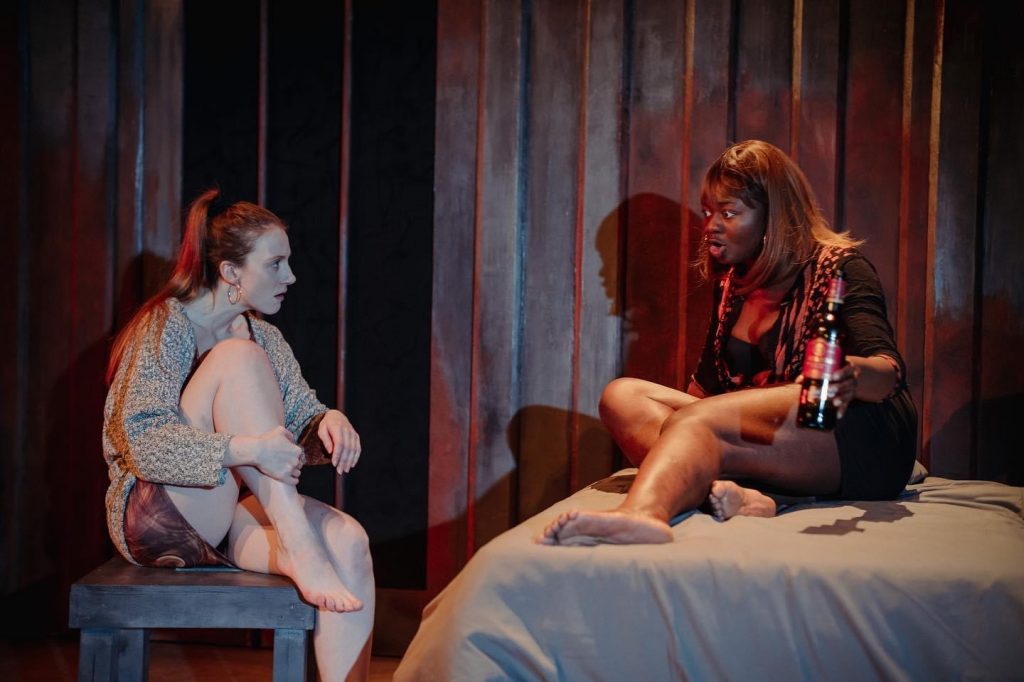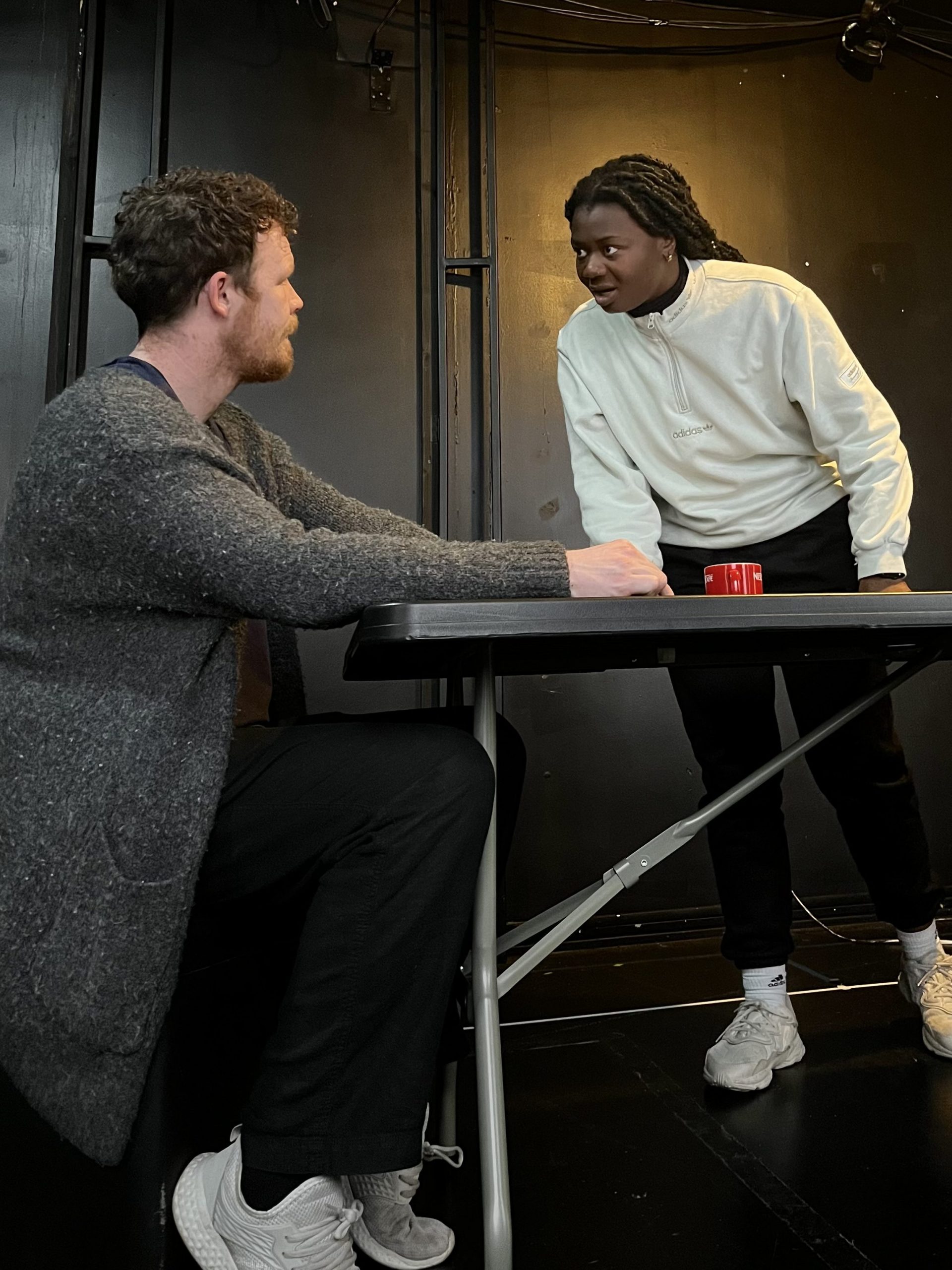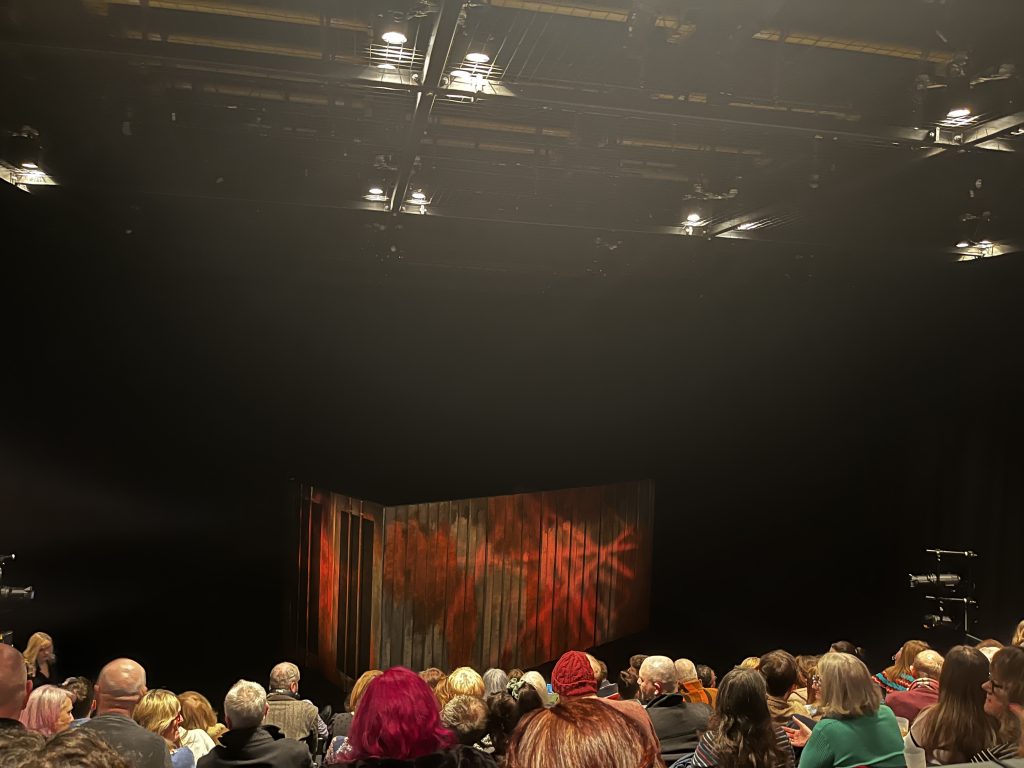Closed Session
During my time at Kabosh, I was primarily production assistant on Rosemary’s Jenkinson’s Silent Trade. In her review of this production Bronagh Lawson (2023) highlights that “although the subject is difficult you leave better informed”. Something that I feel is underestimated by many theatre goers is how truly ‘difficult’ it is to work with subject matter like that explored in Silent Trade. I hope to explore the learning curve of this challenge using Gibbs’ reflective model (Jasper, 2013, 80).

Exposed
Human trafficking. Domestic servitude. Sexual exploitation. Sitting down for a read through of a play that covers such challenging themes, it’s easy to feel overwhelmed. Watching the cast dive into the script for the first time, the challenge of putting this content on the Lyric’s Naughton stage in four weeks was laid bare. However, with Paula McFetridge at the head, and a creative team composed of set designer Tracey Lindsey, lighting designer Mary Tumelty, and sound designer Dan Leith, I felt confident we were in safe hands. However, with two young actresses putting themselves into the theatrical space of a brothel in which they are being forced to sell themselves to pay off a debt, there were concerns for comfort and safety. McFetridge, prioritising the welfare of her team, had pre-empted this challenge and hired choreographer Paula O’Reilly as an intimacy coordinator.
O’Reilly (2021) describes her job simply: “an Intimacy Coordinator ensures the well-being of performers who are being asked to perform simulated sex scenes or other scenes containing intimate content in theatre”. When McFetridge told us that O’Reilly was coming to do a closed intimacy session with Seamus and Lizzie on the ‘brothel’ scene, I requested that the closed session be opened, so I could use it as a learning experience and ease my own discomfort with the challenging content of the play. McFetridge spoke to O’Reilly, Seamus O’Hara and Lizzy Akinbami and the three consented to my presence in the room. O’Reilly began the session by discussing the importance of intimacy coordination, and how this session was to set boundaries and see what would be comfortable for the pair to engage in onstage. She then moved on to a simple exercise where they stood facing each other, and slowly took the time to silently indicate where on their bodies they would feel comfortable with the other touching.

Intimacy and Detachment
Despite the brothel scene initially making me feel distanced from the artistic process due to the challenging content, I feel that although bold, my decision to ask to sit in on the intimacy session was an invaluable one. By ensuring that I had the consent of all of those involved in the session I felt comfortable watching along and learnt an incredible amount. The stress of watching another woman go through a traumatic moment decreased as O’Reilly insisted on linguistic changes, instead of Seamus stroking Lizzie’s leg, it was John (character) stroking Precious’ (character) leg. O’Reilly made choices into ‘stage directions’ so it didn’t feel like it was directly happening to Lizzie, but rather a series of motions she was going through as an actor. I found myself feeling increasingly creatively engaged, as I no longer was viewing the scene as a real event, but instead was able to see it as choreographed movement piece. Interestingly, by making the piece less alive and personal, it became less challenging to watch.
Open Communication
Emilie Pine suggests that “when you are putting suicide on stage, or sexual violence, you have a duty of care to your audience” (Hayes, 2022). I feel by including an intimacy coordinator in the creative process, McFetridge took care not only of her actors, but also the creative team (including myself) and the audience. I was proud that I asked to view the session because once I had an awareness of what the actors were willing to participate in, and that they knew each other’s boundaries, it was easier to watch the brothel scene occur repeatedly throughout rehearsals. O’Reilly (2021) describes in further detail that her job includes the assurance “that what we are asking the audience to watch is essential to the storytelling without being gratuitous and unnecessary.”. O’Reilly and McFetridge stripped the scene back to intimate touches that would have been appropriate for teenagers, despite the uncomfortable tone of the piece. This was an excellent learning experience for me, having never seen an intimacy coordinator work before, I am delighted to not only better understand the creative process, but also improve my awareness as a young creative who would like to make rehearsal spaces feel as safe as McFetridge does.

Dangerous Place for Women
The WHO (2021) estimate that 1 in 3 women globally are victims of sexual violence. It is not a surprise then that myself, and the members of the company, cast and crew found the content of Silent Trade challenging. Not only was it difficult to hear, but it became increasingly difficult to see as the production came to life. At the beginning of the rehearsal process, O’Hara’s excellent performance as the sleazy PSNI officer attempting to ‘infiltrate’ the brothel in which trafficked Nigerian woman Precious (Akinbami) is being exploited was spine-tingling in its discomfort. Hayes claims that “The most dangerous place for a woman in Ireland is on the stage”, due to the increasing number of productions that feature sexual violence against women (2022). The inclusion of O’Reilly as intimacy coordinator ensured that this production was as comfortable for the cast, but also crew and creatives, as possible.
Protection
Overall, I feel that asking to sit in on the intimacy session was the most illuminating choice I made while on work placement. Seeing how easily mitigated the risk to the actor’s mental health was, overcoming the challenging nature of the content and the detachment I felt from the process made me truly appreciate the growing adoption of intimacy coordination. O’Reilly and McFetridge were successful in their selection of what was necessary to tell the story, without being gratuitous in the sexuality of the show, as was demonstrated by audience feedback in post-show discussions. Hirsch asks: “How can we allow the knowledge of past atrocity to touch us without paralyzing us?”, and I believe that, having witnessed the intimacy session and the subsequent open rehearsals, intimacy coordination is an excellent way to explore traumatic and challenging content onstage without retraumatising actors, creatives and audiences (Pine, 2020, p96).

Intimacy Going Forward (The Morning After)
Going forward, I hope that if similarly challenging content comes up, I would encourage myself and other creatives to include at least one session with an intimacy coordinator to open dialogue about what participants boundaries are. I feel that considering the comfort of not only performers, but also those who must repeatedly watch challenging scenes and hear them casually discussed in rehearsal, is essential to creating the safest and most creative atmosphere for artists to work in. I would recommend also, to anyone who works on content pertaining to violence against women onstage, to read Hayes’ article on the danger this presents for actors, and the importance of representing not only stories of female suffering, but also stories of female empowerment and strength: https://www.thetimes.co.uk/article/women-in-theatre-is-there-too-much-tragedy-on-the-irish-stage-77tvn8lgn
Bibliography:
Hayes, Katy. (2022). ‘Women in theatre: is there too much tragedy on the Irish stage?’. The Times. https://www.thetimes.co.uk/article/women-in-theatre-is-there-too-much-tragedy-on-the-irish-stage-77tvn8lgn [Accessed: 03/04/23]
Jasper, Melanie. (2013). Beginning Reflective Practice. 2nd Ed. Boston: Cengage Learning.
Lawson, Bronagh. (2023). ‘ARTS: Silent Trade’s loud scream of outrage echoes from behind the city’s curtains’. Belfast Media. https://belfastmedia.com/silent-trade [Accessed: 09/04/23]
O’Reilly, Paula. (2021). ‘Interview with Intimacy & Movement Director Paula O’Reilly’. Kabosh. https://kabosh.net/interview-with-intimacy-movement-director-paula-oreilly/ [Accessed: 14/04/23]
Pine, Emilie. (2020). ‘The Witness as Commodity: Autoperforming Memory’ in The Memory Marketplace: Witnessing Pain in Contemporary Irish and International Theatre. Bloomington: Indiana University Press. pp. 94-122
World Health Organisation. (2021). ‘Violence Against Women’. https://www.who.int/en/news-room/fact-sheets/detail/violence-against-women [Accessed: 13/04/23]
A Bit of Courage Goes a Long Way
Overcoming Obstacles
You May Also Like

The World of Theatre upon Reflection
30 November 2022
Challenge Accepted Sir!
18 April 2023
